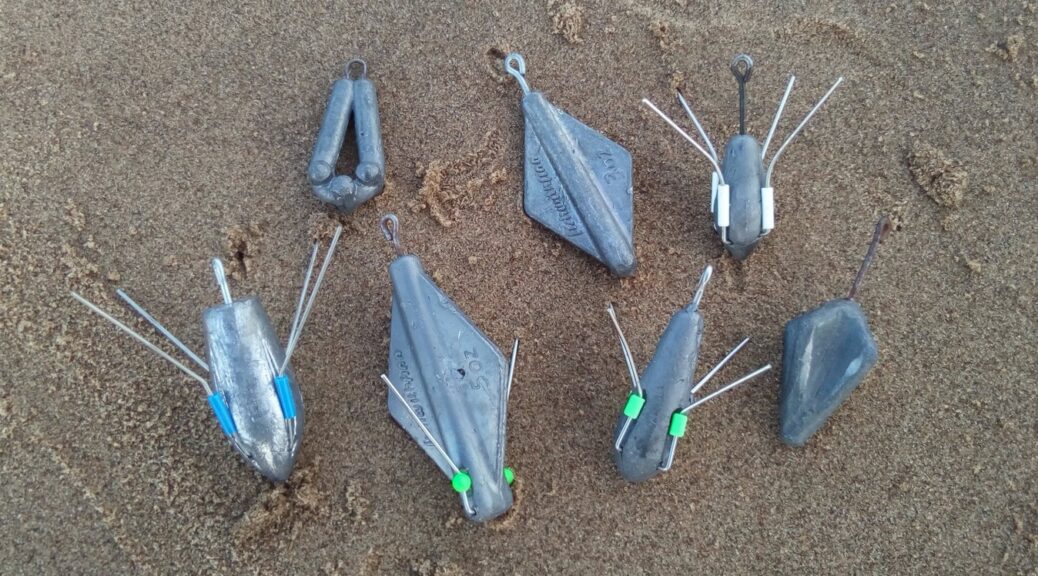
Sea fishing weights guide: which sinker should you use?
Sea fishing weights are nearly as essential as line and hooks when it comes to sea fishing. Using the right type of weight can improve your catch rates dramatically. In this post I describe the different types of sea fishing weights I use.
Grip lead weights
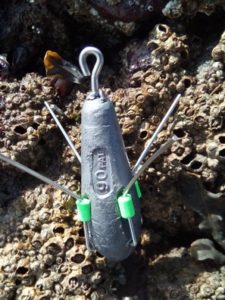
Grip weights have wires that help to nail the rig to the seabed. Plain weights are moved about by the tide, making fishing in some conditions near impossible. Unless you’re fishing clean ground, a moving rig will end up in a snag eventually. A plain weight is also more likely to drop into holes or cracks.
The most used type of sea fishing grip weight is probably the breakout type. The wires snap loose under pressure, making it easier to retrieve. When the current is so strong that it pulls the wires loose it might be necessary to use a fixed wire weight. It’s also possible to make your breakout weight into a ‘semi-fixed grip weight’ by tying an elastic band around it. The wires will still come loose under high pressure.
There are a lot of variations of this type of sea fishing weight:
Breakaway impact lead
The breakaway impact lead allows you to clip your rig down to the weight (in stead of using a device like an impact shield). Just be aware that on a tensioned rig, the snood takes a lot of strain during the cast so when you’re using lighter breaking strain snoods an impact shield is a better option.
Namix grip leads

I really like the namix grip leads because they cast really well. The flat back helps to protect your bait during the cast too. Some of them come with a bait clip attached, but it’s not as fail-safe as the impact lead. You can use these as plain weights too.
Finn breakfree lead weights
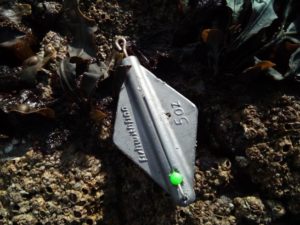
The Finn breakfree lead is designed to serve both as a weight and a lead lift. The idea is that the flat, winged shape helps to bring it to the surface quicker. This can save you a lot of tackle when you have to retrieve over rough ground.
But I found that the Finn weights have another big advantage. My biggest problem with most grip leads (especially flat backs) is that they can get buried when there is a good surf running. A buried lead can be impossible to pull out, especially when using light lines (but I snapped lines up to 30lb). Because of it’s shape, and because it only has two wires the Finn weight doesn’t have this problem. As I often use a light mainline with a tapered shock leader on clean beaches, this has a huge advantage. They also cast surprisingly well. Plain weights are also available for when there’s no need for grippers.
Gemini breakout weights
Gemini designed weights with screw on type grip heads, which allows you to adjust the weight to the situation. Gemini also sells flat back leads, which have similar advantages to the Namix leads.
Fixed type grip weights
Fixed type grip weights are mostly used for boat/ pier fishing in strong tides. Retrieving fixed type grip leads over shallow beaches is a real pain. I only use fixed wire grip weights for my shore fishing when I have no other choice. For rough ground I prefer to use the Breakaway impact softy leads. The wires are strong enough to hold bottom, but straighten easily when you get snagged. At some marks I seem to lose less of these than of the standard breakaways.
Light grip lead weights

Because I like to use as light tackle as possible, I use grip weights as light as 2oz. Combined with a light line (less drag in the tide) they work remarkably well. Breakaway sells 3oz grip weights, but unfortunately shops rarely stock grip weights lighter than that. I bought mine here.
Plain sea fishing weights
Grip leads are necessary a lot of the time, but when I can get away with another type of lead I will. When the current is not too strong and I’m fishing on sand I rarely use grip leads. A moving rig is more likely to end up in fish holding features like holes and gulleys. Also the wires don’t always come loose on sand, which can be a real pain on the retrieve (dragging it over sand banks, etc.).
Pear shaped sea fishing weights
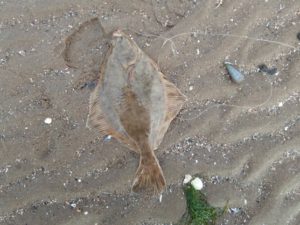
Pear or bomb shaped sea fishing weights are the most common. Because of their aerodynamic shape, they cast really well. I use these types a lot when there is very little current. They roll around quite a bit, even in a gentle tide which can help to find the fish.
Coin shaped sea fishing weights
Coin shaped weights are flat, which means they roll around less than pear shapes weights. If the current is too strong to use pear shaped weights (the rig moves too fast in the tide/ get’s blown ashore) I use these.
Aquapedo weights
Aquapedo weights are another good option when the tide is slightly stronger. They are a lot more aerodynamic than the coin shaped ones and hold bottom a bit better.
Finn weights
The plain Finn weights are also a good option when the tide is slightly stronger.
Drifting weights
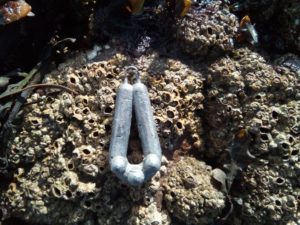
Drifting weights have little domes on them that prevent the lead from moving to quickly. These weights also stir up the sand when moved which attracts flat fish. Although these weights are mostly used for boat fishing for plaice and turbot – drifting over sandbanks, etc – the lighter sizes are really good for beach fishing too. I often use the 1,5 oz version in calm conditions or in estuaries.
Pyramid weights
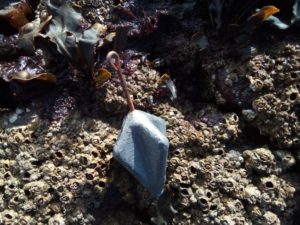
Pyramid weights are my last resort before I reach for my grippers. There are different types of pyramid weights. The ones with the flat back hold bottom almost as well as grip leads, but they do tend to bounce/ drag through the sand on the retrieve. The ones I prefer have a slightly more star shaped design.
Breakaway also introduced their version of the pyramid weights, these ‘Continental Impact Leads’ are great if you want to clip your rig down.
Drilled bullet weights
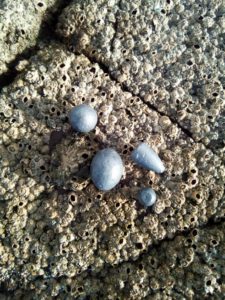
There are different shapes of drilled bullet weights. The bigger sizes are often egg-shaped, while the smaller ones are round. Bullet weights are mostly used for float fishing, but can also be used to make running ledger rigs (as I described in my easy rigs post). The ones that look the most like an actual bullet are mostly used for lure fishing with soft plastics (Texas rig/ Carolina rig).
Alternative sea fishing weights
Sea fishing weights are expensive and if you often fish rough ground like I do, it quickly adds up. Besides, lead is a toxic metal, so best not to litter the sea bed with it.
Stones as weight
As I described in my post on rough ground fishing I often use stones as alternative sea fishing weights. Stones work best if you’re fishing close in in calm seas. To reach the same weight as lead sinker, a stone needs to be roughly 3 times as big. For that reason, anything over 4oz becomes a bit problematic. Big stones cause a lot of resistance on the retrieve which can be a problem when you’re fighting a big fish. I like to use a rotten bottom clip and a weak link with a very low breaking strain <10lb when I use bigger stones so they get dropped every time, snagged or not.
You can create stone fishing weights by wrapping them in garden wire and glueing the wire to the stone with hot melt glue. If you’re really crafty, like this fisherman, you can even drill holes in them and fix eyelets and swivels with putty.
If there is no need to cast you can tie square shaped stones directly to your weak link with a uni knot. Tied like this stones come off very easily, as the knot tightens over the sharp parts of the stone.
Spark plugs
Used spark plugs make great alternative sea fishing weights. Just ask your car mechanic to keep you some.
What are your favourite sea fishing weights? Please share your experiences in the comment section below!
And if you’d like to receive an email every time I publish a new post, please subscribe to my newsletter. Tight lines!
Disclosure: if you purchase anything using the links in this blog post, I might make a commission. Affiliate programs and affiliations include, but are not limited to, the eBay Partner Network. It doesn’t cost you a penny more to buy via these affiliate links (and you don’t have to use them of course) but it helps me to keep this blog going. Thanks!